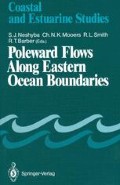Abstract
CTD data and short-term current data collected on METEOR Cruise No. 64 in January and April 1983 off Morocco are used to discuss the wind-induced upwelling situation at 32°N during the time of observation and the subsurface circulation off the Moroccan coast.
During the station work at 32°N, the vertical cross-sections of temperature and salinity clearly suggest upwelling during January and April. The short current records over about 60 hours in April indicate offshore flow in the surface layer. At depths around 250 m, the water moves onshore toward the shelf compensating the upwelling. The maximum depth from where the water ascends up the slope onto the shelf is deeper than 300 m.
Below 500 m depth the observed currents have a north component of a few centimeters per second extending down to the upper boundary of the Mediterranean water at about 1000 m depth. This poleward-going undercurrent is the deep part of the same subsurface flow which occurs along the continental slope off Mauritania. But in the south, the undercurrent extends from depths around 1000 m upwards to the lower boundary of the wind-driven surface layer or even to the surface. The deeper part of the undercurrent (approximately between 700 m and 1000 m) carries Antarctic Intermediate Water (AIW) toward the north. The upper part has a subsurface velocity maximum between 100 and 400 m depth and is characterized by substantial admixtures of South Atlantic Central Water (SACW), off Senegal and Mauritania from about 14°N to 21°N. This flow represents the major subsurface source for the waters upwelling along the shelfbreak and the coast.
Further north, between 21°N and 24°N, the upper undercurrent hits the Canary Current flowing toward the southwest at these latitudes. The convergence produces the frontal zone between NACW and SACW and forces the poleward-going under/counter-current within the upper 400 m to flow parallel to the Canary Current and the frontal zone toward the southwest.
The deeper part of the undercurrent merges below the Canary Current and continues its way toward the north. The transport of AIW along the continental slope can be identified at depths between 800 and 900 m as far north as the Canary Islands. At these latitudes the identity of AIW vanishes due to mixing, but the deep northward-going flow still occurs north of this latitude at 32°N.
Access this chapter
Tax calculation will be finalised at checkout
Purchases are for personal use only
Preview
Unable to display preview. Download preview PDF.
Author information
Authors and Affiliations
Editor information
Editors and Affiliations
Rights and permissions
Copyright information
© 1989 Springer-Verlag New York, Inc.
About this chapter
Cite this chapter
Mittelstaedt, E. (1989). The Subsurface Circulation along the Moroccan Slope. In: Neshyba, S.J., Mooers, C.N.K., Smith, R.L., Barber, R.T. (eds) Poleward Flows Along Eastern Ocean Boundaries. Coastal and Estuarine Studies, vol 34. Springer, New York, NY. https://doi.org/10.1007/978-1-4613-8963-7_9
Download citation
DOI: https://doi.org/10.1007/978-1-4613-8963-7_9
Publisher Name: Springer, New York, NY
Print ISBN: 978-1-4613-8965-1
Online ISBN: 978-1-4613-8963-7
eBook Packages: Springer Book Archive

